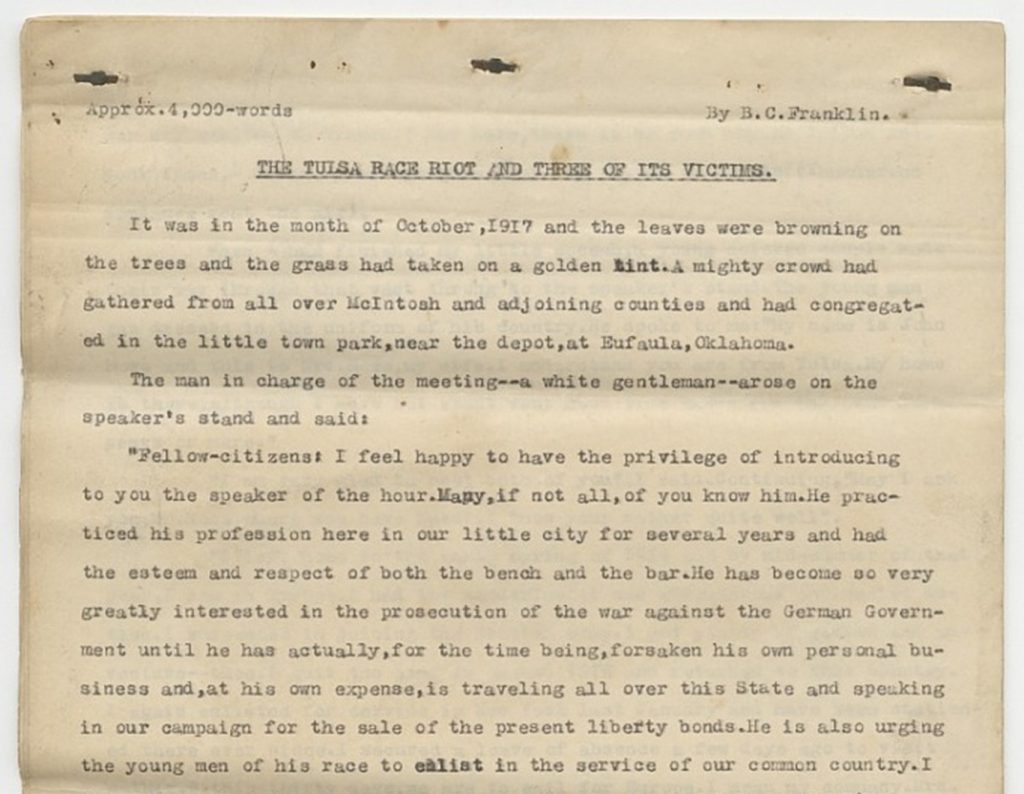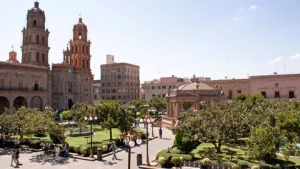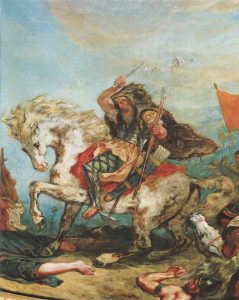
On the night of May 31, 1921, the black community of Tulsa Oklahoma’s Greenwood district would fall victim to one of the deadliest and most destructive episodes of racial violence in American history.1 As described in his manuscript, “The Tulsa Race Riot and Three of Its Victims,” Buck Colbert Franklin described the devastation of homes and businesses being bombed while black owners helplessly watched and were gunned down in the middle of the street that awful night. The prominent lawyer found himself frightened at the sound of multiple gunshots ringing in the air near his law office on Greenwood Avenue. Franklin witnessed the chaos of a feverish crowd, and suddenly he knew that he was witnessing a race riot, or “massacre,” as it was beginning to transpire.2
Buck Colbert Franklin was born on May 6, 1879, as one of ten children. Buck was named after his grandfather, who had been a slave and who had bought his family’s freedom. However, historians speculate that the freedom of the Franklins’ was actually credited to Buck’s father when he ran away from his plantation during the Civil War and then changed his name. Many years later, Franklin had come to Ardmore, Oklahoma, where he was practicing law. He often experienced racial prejudice there, because Ardmore was a predominantly white town. Franklin then decided to move to the predominantly black community of Rentiesville, Oklahoma. There, in 1915, Buck C. Franklin married Molly Parker and they began their family, having four children. One of them, son John Hope Franklin, would later become a notable historian and civil rights advocate. In 1921, Franklin moved away from his family, leaving them in Rentiesville, for the thriving black district of Greenwood in Tulsa Oklahoma. There he established a law office, and later his family joined him, once he was settled in. However, he would not know of the extremely high racial tensions that shaped the horrid events soon to take place just outside his law office.3

Racial tensions in Tulsa had been growing partly because of the prosperous community of Greenwood. Though historians debate how quickly Greenwood became the center of an affluent African-American community, by the early twentieth century, the economic success of Greenwood was well established, and it became known as “Black Wall Street.”4 The affluent black community consisted of thirty-five blocks, which was home to about six thousand residents, dozens of small businesses, newspapers, lawyers and doctors offices, and a school, all of which would be burned and destroyed due to the strong racist attitudes of the time. The popular aspirations of an African-American community would become the setting for a massive hate crime sparked by an incident that forever ruined the prosperity of the thriving area.5
On the afternoon of May 31, a newspaper article was released in the Tulsa Tribune titled “Nab Negro for Attacking Girl in Elevator,” which reported on a trial that involved a black man who allegedly attacked and attempted to rape a young white elevator operator earlier that morning.6 The trial debated of what actually happened in the elevator when Sara Page ran out screaming, alarming a nearby worker while nineteen-year-old Dick Rowland ran from the scene. Yet, the only reports of the incident came from police reports given by Sara Page and by the other witness, so it remained unclear what Rowland’s side of the story was, though speculations assumed that Rowland may have slipped and accidentally grabbed Page to steady himself.7 Nonetheless, the accusations were enough for police to arrest Rowland, and the white community spread talk of lynching him. Alarmed black citizens went to the courthouse, determined to protect Rowland from the angry white mob. The tension between the two parties in front of the courthouse steadily built during the afternoon hours and into the night.8 That’s when the riot erupted. “The panic, fear, and anger loosed by those first shots at the courthouse chased all reason from the streets of Tulsa.”9 The spark of a war between the black and white communities of Tulsa that dark night was lit, and there was no stopping it until the break of dawn.

Referring to the entire chaos of that grim night in Tulsa as a “riot” would be an understatement. What started out as a riot escalated to an all-out war zone as city leaders believed that, “what black Tulsans thought of as protecting a fellow African American through a display of unity, whites interpreted as an act of uprising.”10 Charles Daley, a major in the Oklahoma National Guard and assistant chief of the Tulsa Police Department, ordered the deployment of the national guard after he reported that, “thousands of persons… including several hundred women, and men armed with every available weapon in the city taken from every hardware and sporting goods store, swarmed… avenues watching the gathering volunteer army.”11 When martial law was declared, the police and national guard were sent to the major entrances of the district to prevent the anticipated attack on the white parts of the city.12 However, the police deputized and armed about 250 men that turned their attention to disarming and taking into custody the African Americans in Greenwood, killing anyone who did not surrender.13
That night, Buck C. Franklin did not know that the chaotic atmosphere outside his residence and office in Greenwood would turn into a “race war.” In his manuscript, Franklin described that from the setting of the dark skies, he could hear gunshots ringing in the distance. First assuming that they were just warning shots, he laid down, unbothered by the distant echoes. Then, he heard shots, one after another increasing as the hours of the night deepened, and he suddenly felt disturbed and anxious. It began to dawn on him that this was the response to the news article about the purported assault and rumors of a lynching. Distressed, Franklin called the sheriff’s office multiple times to find out any information, but each time, he could not get a connection. So he decided to leave his residence and hurry to his office to try and call from there. On Greenwood Avenue, Franklin, “found the streets congested with humanity and vehicles of all kinds,” before reaching his office to call the sheriff.14 Once again, his call did not connect to the sheriff’s office and he could not find out any information. He struggled for an hour to find out any news of what was going on from the people who were crowding the streets, but with a “mob mentality,” no one paid any attention to his worries.15

Then, Franklin returned to his hotel to lay back down as he, “soliloquized, ‘Here I am, a peaceable and law-abiding citizen, I have harmed no one–just like thousands of others of my race here–and yet I cannot now walk the street, upon a peaceful mission, in safety.’”16 At around midnight, Franklin awoke to the sound of bullets whistling in the air, raiding the exposed crowds. He wrote, “I saw the top of stand-pipe hill literally lightened up by the blazes that came from the throats of machine guns, and I could hear bullets cutting the air.”17 The fire of machine guns from the national guard would not be the only firestorm that he and the other black citizens would see that dreadful night. Buck C. Franklin witnessed planes circling mid-air dipping low towards the city as buildings all around began to burn from the top. The sound of hail echoed one after another, on to the next building and then the next, nonstop. The flames left behind from the aerial attacks roared through the early morning of June 1 with dense smoke covering the sky. “Lurid flames roared and belched and licked their forced tongues in the air. Smoke ascended the sky in thick, black volumes and amid it all, the planes–now a dozen or more in number still hummed and darted…”18 Through the massacre, he encountered a WWI veteran who had just returned home, a brave mother saving her child, and other citizens young and old, who did not survive the day “hell was on earth.”19
The fire department never showed up to try to stop the dozens of fires that consumed “Black Wall Street,” leaving the charred bones of buildings and businesses in deep ashes and ruins. After the massacre, it had been estimated that about 1,200 homes were destroyed and 300 people were killed. The remaining black citizens of Tulsa were rounded up and imprisoned for about eight days.20 The horror and destruction were documented through photos taken by newspapers, white citizens who celebrated the atrocity, and black citizens who mourned the loss of their home and remembered the violence.21
The manuscript that was written by Franklin detailing the events of that night also provided unique documentation of the unlawful attack committed by the city of Tulsa, Oklahoma. His eyewitness account of the black community being bombed by aerial attacks challenged the position of the city of Tulsa, who initially denied all participation in the cruel destruction. Before the Oklahoma Supreme court, Franklin led the legal battle against the City of Tulsa, challenging the ordinance that the victims of the attack could not rebuild their burnt down community. To this day, the victims of the 1921 Tulsa Massacre are still looking for justice and reparations as the Greenwood district has not been able to recover from the damage.22 Hundreds of families suffered at the hands of white citizens armed by the city, yet, this is not taught in schools across America. Although progress had been made from racial violence in the United States, the fight for social justice still remains and cannot be ignored.
- Randy Krehbiel, Tulsa 1921: Reporting a Massacre (Norman: University of Oklahoma Press, 2019), 32. ↵
- Buck C. Franklin, “The Tulsa Race Riot and Three of Its Victims,” Collection of the Smithsonian National Museum of African American History and Culture, August 22, (1931), 4. ↵
- Ephrem Yared, “Buck Colbert Franklin (1879-1960),” Blackpast (website), April 22, 2016, https://www.blackpast.org/african-american-history/franklin-buck-colbert-1879-1960/ ↵
- Randy Krehbiel, Tulsa 1921: Reporting a Massacre (Norman: University of Oklahoma Press, 2019), 6. ↵
- Encyclopedia of African American History, 2010, s.v. “Tulsa, Oklahoma, Race Riot of 1921,” by Alfred Brophy. ↵
- Encyclopedia of Race and Crime Vol.2, 2009, s.v. “Tulsa Oklahoma, Race Riot of 1921,” by Vincent E. Miles. ↵
- Alfred L. Brophy, Reconstructing the Dreamland: The Tulsa Riot of 1921: Race, Reparations, and Reconciliation (Oxford; Oxford University Press, 2002), 24-25. ↵
- Encyclopedia of African American History, 2010, s.v. “Tulsa, Oklahoma, Race Riot of 1921,” by Alfred Brophy. ↵
- Randy Krehbiel, Tulsa 1921: Reporting a Massacre (Norman : University of Oklahoma Press, 2019), 45. ↵
- Randy Krehbiel, Tulsa 1921: Reporting a Massacre, (Norman : University of Oklahoma Press, 2019), 44. ↵
- Randy Krehbiel, Tulsa 1921: Reporting a Massacre, (Norman : University of Oklahoma Press, 2019), 44. ↵
- Randy Krehbiel, Tulsa 1921: Reporting a Massacre, (Norman : University of Oklahoma Press, 2019), 44. ↵
- Encyclopedia of African American History, 2010, s.v. “Tulsa, Oklahoma, Race Riot of 1921,” by Alfred Brophy. ↵
- Buck C. Franklin, “The Tulsa Race Riot and Three of Its Victims,” Collection of the Smithsonian National Museum of African American History and Culture, August 22, 1931, 3. ↵
- Buck C. Franklin, “The Tulsa Race Riot and Three of Its Victims,” Collection of the Smithsonian National Museum of African American History and Culture, August 22, 1931, 3-4. ↵
- Buck C. Franklin, “The Tulsa Race Riot and Three of Its Victims,” Collection of the Smithsonian National Museum of African American History and Culture, August 22, 1931, 4. ↵
- Buck C. Franklin, “The Tulsa Race Riot and Three of Its Victims,” Collection of the Smithsonian National Museum of African American History and Culture, August 22, 1931, 4. ↵
- Buck C. Franklin, “The Tulsa Race Riot and Three of Its Victims,” Collection of the Smithsonian National Museum of African American History and Culture, August 22, 1931, 6. ↵
- Buck C. Franklin, “The Tulsa Race Riot and Three of Its Victims,” Collection of the Smithsonian National Museum of African American History and Culture, August 22, 1931, 6. ↵
- Allison Keyes, “A Long-Lost Manuscript Contains a Searing Eyewitness Account of the Tulsa Race Massacre of 1921,” Smithsonian (website), May 27, 2016, https://www.smithsonianmag.com/smithsonian-institution/long-lost-manuscript-contains-searing-eyewitness-account-tulsa-race-massacre-1921-180959251/ ↵
- Alfred L. Brophy, Reconstructing the Dreamland: The Tulsa Riot of 1921: Race, Reparations, and Reconciliation (Oxford; Oxford University Press, 2002), 63. ↵
- Ephrem Yared, “Buck Colbert Franklin (1879-1960),” Blackpast (website), April 22, 2016, https://www.blackpast.org/african-american-history/franklin-buck-colbert-1879-1960/ ↵



60 comments
Allison Grijalva
This was a great article! It is sad to see this article and the topic of discrimination and about a massacre that was truly senseless. This is something that is unfortunately not isolated in our nation’s past, but takes different forms in modern days as well. I cannot imagine walking into the street and being placed in a warzone like the article describes.
Genesis Vera
I had very limited knowledge on this subject so I had an idea of what this article was going to be focusing on. Nonetheless, I thought the article provided a good amount of information. It was definitely one of the sadder articles I have read but I think that’s what makes it so good. I enjoyed that you did not hold back and made the reader face the tragedy of Tulsa.
Manuel Rodriguez
Alicia, great job on your article! It was well written and well organized. Thank you for your contribution in making sure that anyone who encounters this article is reminded of the history of injustices that are so deeply rooted throughout different periods of time in our nation’s history. The events that occurred in Tulsa were horrific. It is deeply disturbing that skin color could provoke such a heinous act of violence and lead to the destruction of 1200 homes and 300 senseless deaths. Once again, thank you for constantly reminding us of significant events like these that tell us to always strive to be better.
Victor Rodriguez
Just another incredibly heartbreaking tragedy about racial discrimination in our history. The Tulsa Massacre is something verifies that our society is ignorant and that needs a lot of correction. Even though this event was a long time ago, there still continues to be a lot of hate and discriminatory acts in people. We should all be equal and treated in a fair manner. African Americans have been mistreated and oppressed far too long and we must unite so that it stops as soon as possible. We are are human beings and deserve the same respect. The golden rule of treating others the way you would like to be treated to be something we should always take into consideration.
Alexandria Garcia
This article was most definitely a meaningful addition to the St. Mary’s History Project. As a member of the black community, I think we can universally agree that this was one of our greatest heartbreaks in history. In a time period of what seemed to be getting better, this article does a great job of proving that speculation wrong. The Tulsa bombings and riots put a dent in the Black community forever.
Andrew Gallegos
No words explain how good this article is I love reading about racism it’s such a good topic to write about. It’s so depressing how African Americans got treated and how so much hate was towards them. They got treated so badly but for what though. Racism still goes on today and it’s sad to say it.
Maya Simon
This was a great article Alicia. It was interesting to find out that it was triggered by the arrest of a 19-year-old Dick Rowland, an African American shoeshiner, who worked in the white downtown business area of Tulsa. The massacre left somewhere between 30 and 300 people dead, mostly African Americans, and destroyed Tulsa’s prosperous Black neighborhood of Greenwood, known as the “Black Wall Street.” More than 1,400 homes and businesses were burned, and nearly 10,000 people were left homeless.
Davis Nickle
This was a very interesting moment in history to read about. To think that we had almost had a full on battle break out in the United States is a strange thought. The quotes from Franklin really put into perspective how terrifying and surreal the entire situation must have been. From the sounds of it, the streets were turned into a warzone, and like the article says, this seemed like much more than riots.
Samson Pullattu
There is little that is more tragic than being able to draw numerous parallels between this racially oppressive event and those of today. I have heard of the events in Tulsa during 1921 before but never by following the events of Buck Colbert Franklin. Reading that areas in Tulsa that still have not recovered fully a century later is amazingly devastating. It’s so shameful to see that the country I live in had employed such brutal forces for the sake of racism.
Diego Oviedo
This article was very informative. I had never heard about the Massacre which is strange because one would think that it would have been gone over in history class. After reading this article it was very detailed in describing all that had happened in Tulsa, it’s saddening the reality of how the world is but I am glad this article didn’t hold back.